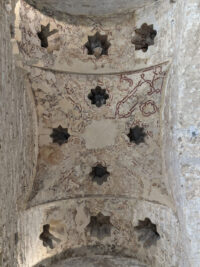 Renovations of a Seville tapas bar have uncovered the remains a 12th century Islamic bathhouse with uniquely rich decorations. The Cervecería Giralda in the historic center of Seville has been one of the city’s most popular bars since it opened in 1923. The building has soaring vaulted ceilings supported by four columns, typical of the medieval bathhouses or hammams, and there are records going back to 1281 referencing a bathhouse that had existed in the area, but there was no archaeological evidence to confirm this was it, and the building was widely thought to be more Neo-Mudéjar (ie, Moorish Revival) than the genuine article.
Renovations of a Seville tapas bar have uncovered the remains a 12th century Islamic bathhouse with uniquely rich decorations. The Cervecería Giralda in the historic center of Seville has been one of the city’s most popular bars since it opened in 1923. The building has soaring vaulted ceilings supported by four columns, typical of the medieval bathhouses or hammams, and there are records going back to 1281 referencing a bathhouse that had existed in the area, but there was no archaeological evidence to confirm this was it, and the building was widely thought to be more Neo-Mudéjar (ie, Moorish Revival) than the genuine article.
The descendants of Roman baths, hammams served the same hygiene and socialization functions as their predecessors as well as performing a religious role as facilities for the full-body ablutions mandated in the Quran for ritual purification. There were hundreds of them in the Muslim-ruled cities. In Spain, Christian rulers who conquered those cities frequently destroyed the bathhouses, built over them or converted them to other uses.
Seville became the capital of Al-Andalus under the Almohad Caliphate which ousted the Almoravid dynasty in a series of battles between 1146 and 1173. They conquered Seville early, transferring the capital from Cordoba to Seville in 1150, but their rule would be short-lived. Seville was conquered by Ferdinand III of Castile in 1248.
Much of Seville’s extant Moorish style architecture was actually built by Christian rulers who appropriated the aesthetic even as they demolished or radically altered the original structures. Today there is only a smattering of original architecture from the Almohad period, including the Giralda bell tower of Seville Cathedral, formerly a minaret of the Great Mosque of Seville, the Patio del Yeso (Courtyard of Plaster) in the Alcázar royal palace, the Patio de los Naranjos, once part of the mosque and now annexed to the Seville Cathedral.
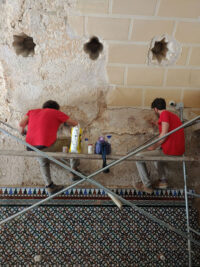 As the name suggests, the Cervecería Giralda is only feet away from the former mosque. The earliest documentary evidence of a bathhouse at the site dates to 1281 and refers to the “baths of García Jofre” adjacent to the cathedral being donated to the Church by King Alfonso X. By the 17th century, the great vaulted building’s history as a hammam was already forgotten. A major reconstruction divided the high ceilings of the warm room into two stories, replaced the original columns and closed the skylights. Historians contended it was the remains of an ancient amphitheater rather than a bath, or a newer construction from the 15th-16th century done in Moorish style.
As the name suggests, the Cervecería Giralda is only feet away from the former mosque. The earliest documentary evidence of a bathhouse at the site dates to 1281 and refers to the “baths of García Jofre” adjacent to the cathedral being donated to the Church by King Alfonso X. By the 17th century, the great vaulted building’s history as a hammam was already forgotten. A major reconstruction divided the high ceilings of the warm room into two stories, replaced the original columns and closed the skylights. Historians contended it was the remains of an ancient amphitheater rather than a bath, or a newer construction from the 15th-16th century done in Moorish style.
Fran Díaz, the architect in charge of the modernization project, was labouring under that same misapprehension when he began renovations last year. He was disabused of the notion when probes behind the false ceiling revealed the presence of skylights known as luceras, decorative cutouts in the ceiling characteristic of hammam architecture. In the wake of the discovery, renovators stepped back so archaeologists could take over to fully explore the remains of the bathhouse.
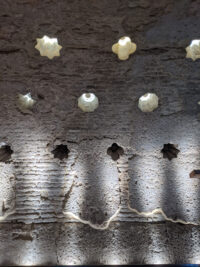 They found 88 skylights in several different shapes — eight-pointed stars, six-pointed stars, octagons, quadrifoils — that are far more elaborate than those found in other Muslim baths of the period. An entirely unprecedented discovery were geometric murals. Nothing like them has been found before in the Iberian peninsula. Painted in red ochre against a white background, the latticed pattern likely represented water. Large sections of it have survived on the walls and ceilings. Archaeologists believe that the entire bathhouse from ceiling to floor was originally painted with these decorations. This is the only known hammam with surviving original wall and ceiling painted decoration. The only other examples of integral decoration in bathhouses stopped at the baseboards.
They found 88 skylights in several different shapes — eight-pointed stars, six-pointed stars, octagons, quadrifoils — that are far more elaborate than those found in other Muslim baths of the period. An entirely unprecedented discovery were geometric murals. Nothing like them has been found before in the Iberian peninsula. Painted in red ochre against a white background, the latticed pattern likely represented water. Large sections of it have survived on the walls and ceilings. Archaeologists believe that the entire bathhouse from ceiling to floor was originally painted with these decorations. This is the only known hammam with surviving original wall and ceiling painted decoration. The only other examples of integral decoration in bathhouses stopped at the baseboards.
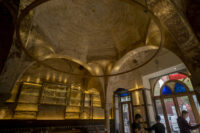 The main space of the bar was the hammam’s warm room. One wall opens into a smaller rectangular space with a barrel-vaulted ceiling that was originally the bathhouse’s cold room. That’s where the skylights are. What is now the kitchen area was the hot room, but most of the original structure was destroyed so all that remains is a partial arch. That the skylights and priceless murals survived at all is thanks to Vicente Traver, the architect who renovated the building in the early 20th century. He could have torn down what was left of the bathhouse, or redone it so invasively that little of the original elements remained. Instead he created the false ceiling and protected the fragile remains.
The main space of the bar was the hammam’s warm room. One wall opens into a smaller rectangular space with a barrel-vaulted ceiling that was originally the bathhouse’s cold room. That’s where the skylights are. What is now the kitchen area was the hot room, but most of the original structure was destroyed so all that remains is a partial arch. That the skylights and priceless murals survived at all is thanks to Vicente Traver, the architect who renovated the building in the early 20th century. He could have torn down what was left of the bathhouse, or redone it so invasively that little of the original elements remained. Instead he created the false ceiling and protected the fragile remains.
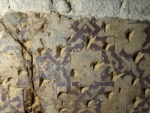 The discovery of the baths spurred a new concept for the renovation of the bar. To preserve the 12th century marvel while still making the space a functioning bar, architectures installed a metal cornice above Traver’s wall tiles. Renovations are scheduled to be completed next month, after which the Cervecería Giralda will reopen with a newly fabulous interior that maintains the striking features of the early 20th century renovation that have become integral to the establishment’s character with the magnificence of the original Almohad hammam.
The discovery of the baths spurred a new concept for the renovation of the bar. To preserve the 12th century marvel while still making the space a functioning bar, architectures installed a metal cornice above Traver’s wall tiles. Renovations are scheduled to be completed next month, after which the Cervecería Giralda will reopen with a newly fabulous interior that maintains the striking features of the early 20th century renovation that have become integral to the establishment’s character with the magnificence of the original Almohad hammam.
That building is undoubtedly a great bathhouse, as it is a great brewery or bar, but isn’t a “cervecería” a BREWERY?!? :confused:
In fact, to actually make the stuff where it is consumed, is a matter of cultural responsibility and awareness, and as such not to be taken lightly.
To clean on the outside in order to wash from the inside makes of course perfect sense. “Kellerbier” -e.g.- is served in a beer garden, where the barrels are lagered below, i.e. in cellars.
Since it does not undergo pasteurization, Kellerbier is best consumed fresh, however, instead of those “skylights” in quadrifoil shapes, the usage of trees is not uncommon.
Do not underestimate that, very much in contrast to a religion that puts an outright ban on the stuff, it is often the religion itself that is actually brewing it.
I can see that on the picture of the painted plaster that someone has first inscribed the pattern on the plaster, effectively creating a massive ‘painting by numbers’ project for someone.